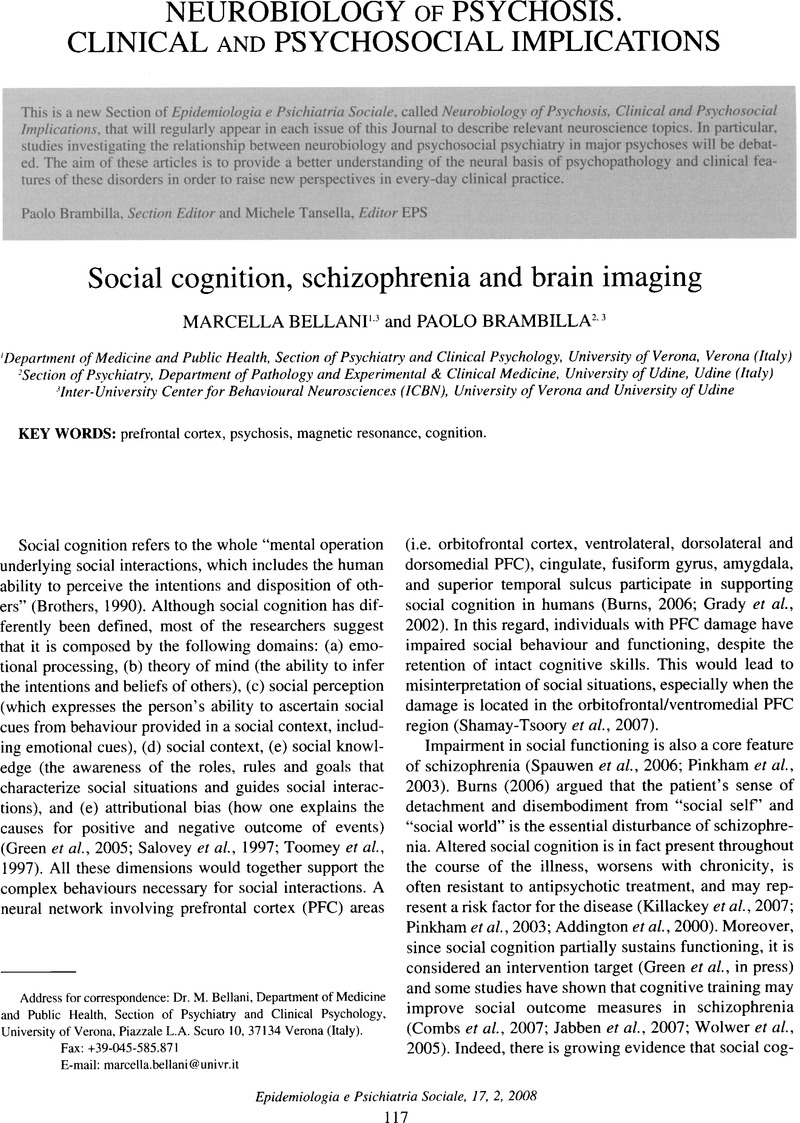Crossref Citations
This article has been cited by the following publications. This list is generated based on data provided by Crossref.
Bellani, Marcella
Yeh, Ping-Hong
Tansella, Michele
Balestrieri, Matteo
Soares, Jair C.
and
Brambilla, Paolo
2009.
DTI studies of corpus callosum in bipolar disorder.
Biochemical Society Transactions,
Vol. 37,
Issue. 5,
p.
1096.
Bellani, Marcella
Tomelleri, Luisa
and
Brambilla, Paolo
2009.
Emotion-Based Decision Making in schizophrenia: evidence from the Iowa Gambling Task.
Epidemiologia e Psichiatria Sociale,
Vol. 18,
Issue. 2,
p.
104.
Lasalvia, Antonio
and
Tansella, Michele
2009.
Childhood trauma and psychotic disorders: evidence, theoretical perspectives, and implication for interventions.
Epidemiology and Psychiatric Sciences,
Vol. 18,
Issue. 4,
p.
277.
Bellani, Marcella
Perlini, Cinzia
and
Brambilla, Paolo
2009.
Language disturbances in schizophrenia.
Epidemiology and Psychiatric Sciences,
Vol. 18,
Issue. 4,
p.
314.
Tomasino, B.
Bellani, M.
Perlini, C.
Rambaldelli, G.
Cerini, R.
Isola, M.
Balestrieri, M.
Calì, S.
Versace, A.
Pozzi Mucelli, R.
Gasparini, A.
Tansella, M.
and
Brambilla, P.
2011.
Altered microstructure integrity of the amygdala in schizophrenia: a bimodal MRI and DWI study.
Psychological Medicine,
Vol. 41,
Issue. 2,
p.
301.
Delvecchio, Giuseppe
Caletti, Elisabetta
Perlini, Cinzia
Siri, Francesca Marzia
Andreella, Angela
Finos, Livio
Bellani, Marcella
Fabbro, Franco
Lasalvia, Antonio
Bonetto, Chiara
Cristofalo, Doriana
Scocco, Paolo
D’Agostino, Armando
Torresani, Stefano
Imbesi, Massimiliano
Bellini, Francesca
Veronese, Angela
Bressi, Cinzia
Ruggeri, Mirella
and
Brambilla, Paolo
2019.
Altered syntactic abilities in first episode patients: An inner phenomenon characterizing psychosis.
European Psychiatry,
Vol. 61,
Issue. ,
p.
119.
Kimoto, Sohei
Makinodan, Manabu
and
Kishimoto, Toshifumi
2019.
Neurobiology and treatment of social cognition in schizophrenia: Bridging the bed-bench gap.
Neurobiology of Disease,
Vol. 131,
Issue. ,
p.
104315.
Zovetti, Niccolò
Rossetti, Maria Gloria
Perlini, Cinzia
Brambilla, Paolo
and
Bellani, Marcella
2021.
Neuroimaging studies exploring the neural basis of social isolation.
Epidemiology and Psychiatric Sciences,
Vol. 30,
Issue. ,
Bellani, Marcella
Zovetti, Niccolò
Perlini, Cinzia
and
Brambilla, Paolo
2022.
Prevention in Mental Health.
p.
203.





